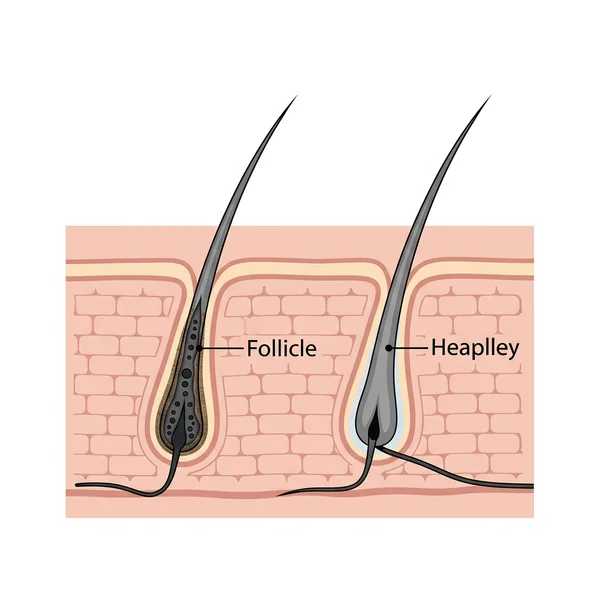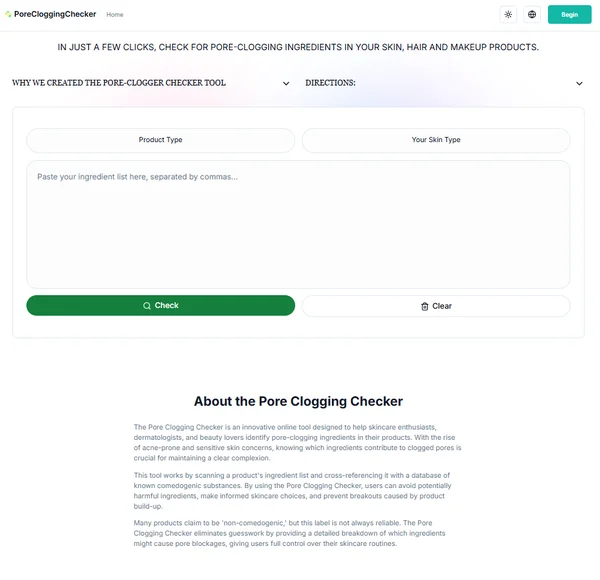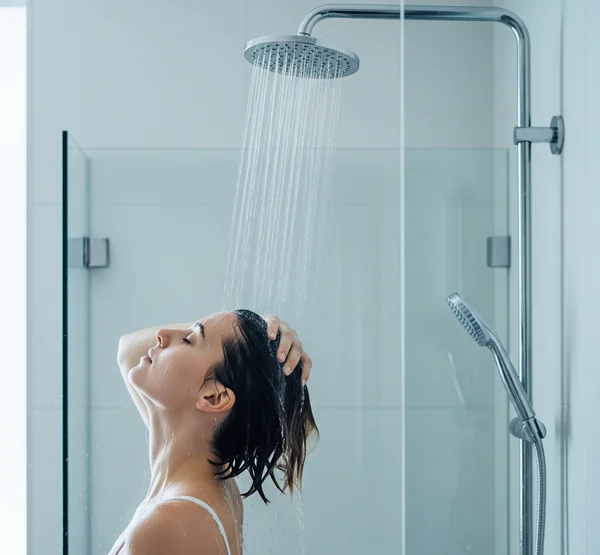Hair Products & Acne: Spot Pore-Clogging Ingredients
Ever wonder why those pesky breakouts keep popping up on your forehead or back, even when your face is clear? The answer might surprise you: your hair products could be the secret culprits. How to check if a product is pore clogging? This guide will reveal how common hair product ingredients can clog pores and lead to hair product acne, and how our Pore Clogging Ingredient Checker can help you identify these hidden triggers to achieve clearer skin. With our free online tool, you can easily check ingredients for acne safety, empowering you to make smarter choices for your skin.

Why Hair Products Can Lead to Breakouts
It might seem counterintuitive, but what you put on your hair can significantly impact your skin, leading to breakouts in unexpected places. Grasping this link between hair products and your skin is crucial for achieving a clearer complexion, especially for those dealing with persistent acne.
How Hair Care Ingredients Transfer to Your Skin
Every time you wash your hair, style it, or even just let it hang, ingredients from your hair products can make skin contact. Shampoos and conditioners rinse down your face, neck, and back in the shower, leaving behind a residue transfer. Styling products can transfer from your hair to your forehead, temples, and even your pillowcase, which then contacts your skin throughout the night. This constant exposure means that anything potentially problematic in your hair products can directly affect your skin.
Understanding Comedogenicity & Its Impact on Scalp/Body Skin
The term "comedogenic" refers to a substance's likelihood of clogging pores. While often discussed in the context of facial skincare, comedogenicity applies equally to the skin on your scalp, back, and chest. When hair product ingredients are comedogenic, they can mix with your skin's natural oils and dead skin cells, forming plugs that block follicles. This creates an ideal environment for bacteria to thrive, leading to inflammation, blackheads, whiteheads, and painful cysts – essentially, body acne causes. Recognizing that your hair products can contribute to clogged pores is crucial for anyone seeking to prevent breakouts.

Top Pore-Clogging Hair Ingredients to Avoid
Navigating ingredient lists can be overwhelming, but knowing some of the most common pore clogging shampoo and comedogenic hair products ingredients can give you a significant advantage. Our goal is to make identifying these culprits as straightforward as possible.
Common Oils & Butters Known to Clog Pores
While many natural oils and butters are celebrated for their moisturizing properties, some can be highly comedogenic, particularly for acne-prone skin. For instance, coconut oil comedogenic ratings are often high, meaning it can be a major trigger for breakouts, especially if it comes into contact with your skin regularly. Similarly, shea butter acne connections are also noted, as it can be moderately comedogenic for some individuals. Other oils like cocoa butter, flaxseed oil, and palm oil can also contribute to clogged pores and breakouts.
Silicones: Friend or Foe for Acne-Prone Skin?
Silicones like Dimethicone are commonly found in hair products for their ability to create a smooth, shiny finish and reduce frizz. The question, is dimethicone comedogenic, is frequently asked. While silicones are generally considered non-comedogenic by themselves and can be beneficial in wash-off products, heavy silicones or a buildup over time can trap other pore-clogging ingredients or lead to silicone build-up that prevents the skin from breathing. It’s about the overall formulation and how thoroughly you rinse them off.
Other Surprising Culprits in Your Hair Care Routine
Beyond oils and silicones, other ingredients can surprisingly contribute to hair product acne. Certain waxes, like Candelilla Wax and Carnuba Wax, are often used for hold and texture but can be highly occlusive and lead to waxes in hair products causing breakouts. Artificial fragrances, while making products smell pleasant, can be a common source of fragrance acne due to skin irritation and potential pore clogging in sensitive individuals. Even some sulfates, while great for cleansing, can be irritating and disrupt the skin barrier, potentially leading to inflammation and subsequent breakouts.
How to Check Your Hair Products for Acne Safety with Our Tool
Identifying pore-clogging ingredients shouldn't require a chemistry degree or endless hours of research. Forget endless ingredient deciphering. Our intuitive tool streamlines the process, making it simple and efficient to ensure your hair care choices actively support clear skin. When you need a quick pore clogging checker, look no further.
Step-by-Step: Analyzing Ingredients with Our Ingredient Checker Tool
Using our ingredient checker tool is incredibly easy. First, locate the full ingredient list on your hair product's packaging or website. Then, simply copy-paste ingredients into the input box on our homepage. Click "Check," and in seconds, our comprehensive database will analyze the list for known comedogenic substances. You'll see any problematic ingredients highlighted, often with their comedogenic rating, so you can clearly understand what might be causing issues. This how to use pore clogging checker guide will quickly make you an expert. Ready to start? Check your products now.

The Benefits of an Unbiased Ingredient Analysis
What sets our free ingredient analysis tool apart is its commitment to unbiased analysis. Our results are based purely on scientific data and a regularly updated database of known comedogenic ingredients, not on brand promotions or affiliations. This provides you with an objective ingredient review, empowering you to make informed decisions without marketing hype. Our tool helps you prevent body acne and face breakouts by giving you the knowledge to choose truly acne safe product checker options, giving you peace of mind with every purchase.
Building an Acne-Safe Hair Care Routine
Knowing which ingredients to avoid is just one part of the solution. The next step is actively building a hair care routine that supports healthy, clear skin. This involves consciously selecting products and adopting beneficial habits. For a comprehensive approach to finding noncomedogenic checker approved items, visit our site.
Selecting Non-Comedogenic Shampoos & Conditioners
When choosing your everyday wash products, opt for formulations specifically labeled "non-comedogenic" or "oil-free," but always double-check the ingredient list using our tool. Look for lightweight textures and steer clear of heavy oils or butters in rinse-off products, especially if they might linger on your skin. Prioritizing best shampoo for body acne and a conditioner for breakouts is essential. Remember to rinse your hair thoroughly, ensuring no product residue is left on your skin.
Choosing Acne-Friendly Styling Products
Styling products, such as gels, mousses, and hairsprays, are often designed for maximum hold and can contain ingredients that are particularly problematic. Seek out non-comedogenic hair gel and hairspray for sensitive skin options. If a product feels heavy or oily, it’s likely to transfer and cause issues. When applying, try to minimize direct contact with your skin, especially around your hairline and neck. Using lighter formulations or applying products only to the ends of your hair can also make a difference.
Hair Care Habits for Clearer Skin Beyond Products
Beyond smart product choices, certain habits can significantly reduce the risk of hair product acne. Always rinse hair thoroughly in the shower, tilting your head back to avoid runoff onto your face and body. Wash your hair before washing your body to remove any residual product from your skin. Change and clean pillowcases frequently, as they can accumulate hair product residue and natural oils, transferring them to your skin overnight. Finally, keep your hair off your face, especially during workouts or hot weather, to minimize skin contact with potentially irritating products.

Last but Not Least
Don't let your hair products be the secret saboteurs of your clear skin goals. By understanding which pore-clogging ingredients to watch out for and utilizing powerful tools like PoreCloggingChecker.org, you can confidently choose products that support a healthy, blemish-free complexion from head to toe. This acne ingredient checker empowers you with knowledge. Take control of your skin's future today by exploring our site and making informed choices for every product in your routine.
Frequently Asked Questions About Hair Product Acne
Can hair products truly cause acne on my face, back, or chest?
Yes, absolutely! Ingredients from your hair products can easily transfer to your skin through rinsing, sweating, or contact with hair, leading to clogged pores and breakouts on your face, neck, back, and chest.
What does "non-comedogenic" mean when it comes to hair care?
"Non-comedogenic" means a product or ingredient is formulated to be less likely to clog pores. While helpful, it's not a guarantee, and it's always best to check the full ingredient list with a reliable tool like PoreCloggingChecker.org.
How often should I check my hair product ingredients?
It's a good habit to check ingredients for any new product you buy. For existing products, consider re-checking if you start experiencing unexplained breakouts, or if the product's formulation might have changed. Our pore clogging checker is always ready for you.
Are natural oils in hair products always safe for acne-prone skin?
Not necessarily. While some natural oils are beneficial, many common natural oils (like coconut oil or shea butter) have high comedogenic scale ratings and can significantly contribute to breakouts for susceptible individuals. Always verify with an acne ingredient checker.
What other habits can help prevent hair product-related breakouts?
Beyond choosing non-comedogenic products, regularly cleaning pillowcases, rinsing hair thoroughly, and keeping hair off your face (especially during exercise) can help prevent hair product acne. Always use a reliable pore clog checker for ingredient verification.
Disclaimer: This article is for informational purposes only and does not constitute medical advice. Please consult a professional dermatologist for any specific skin concerns or medical conditions.